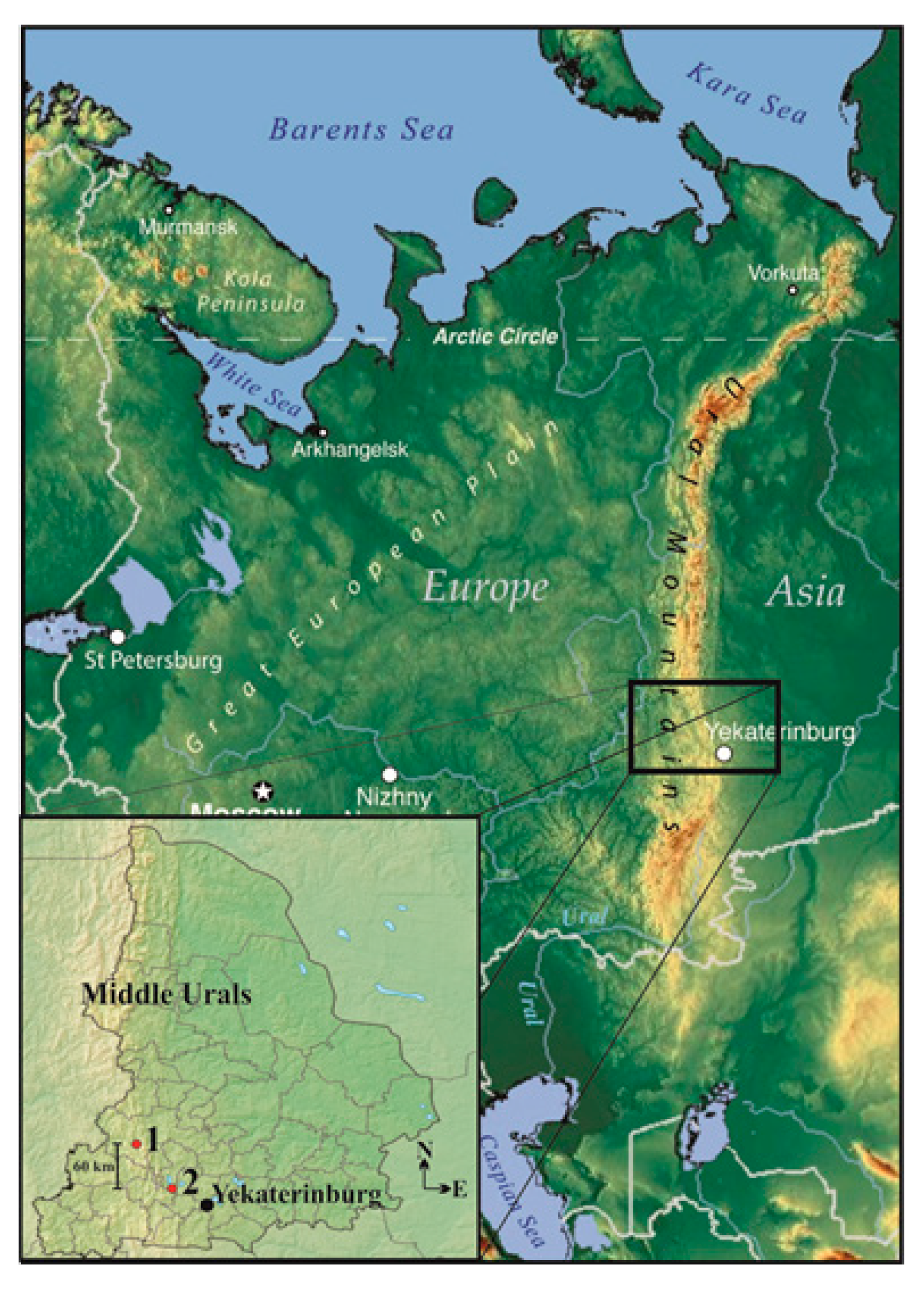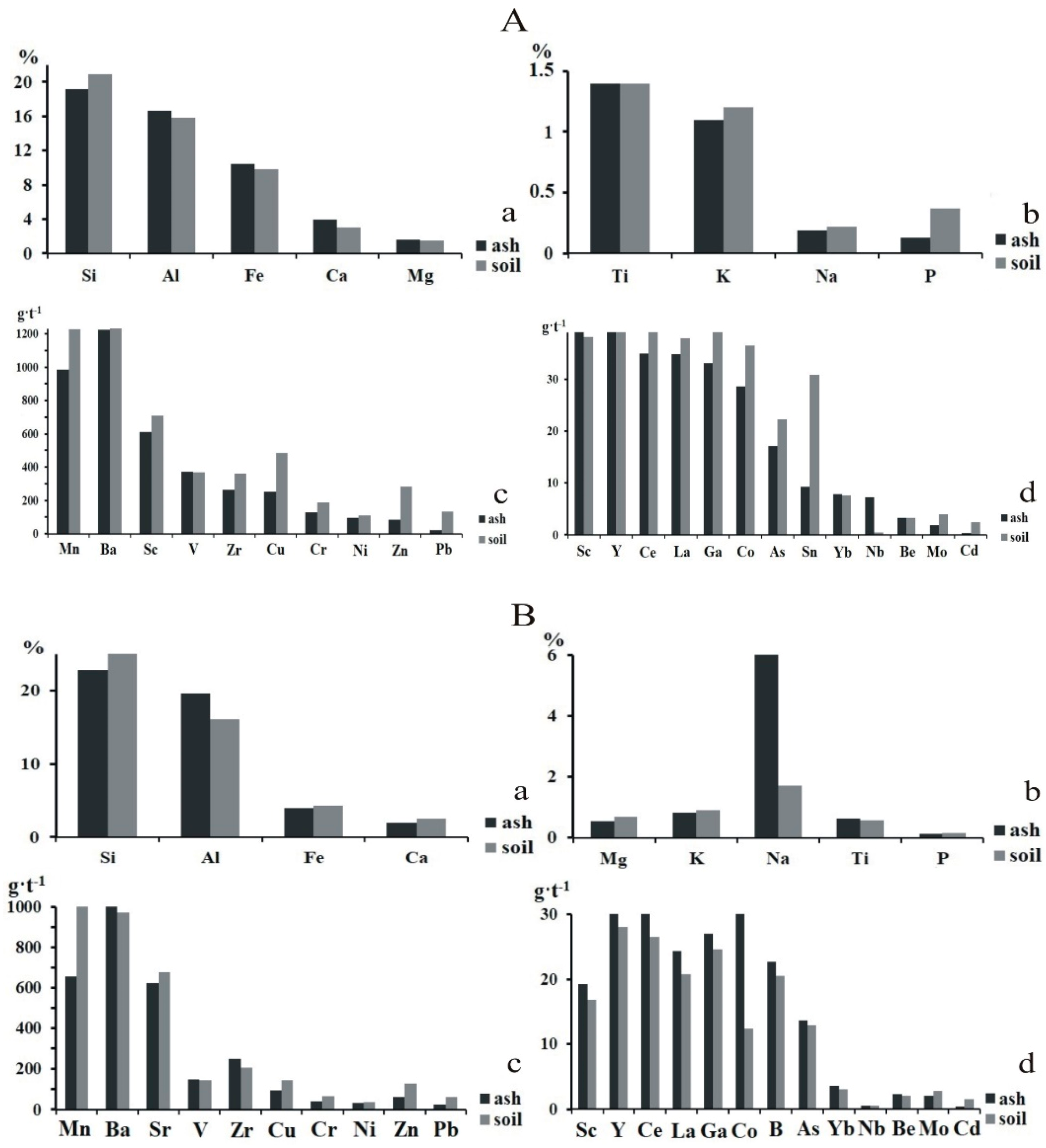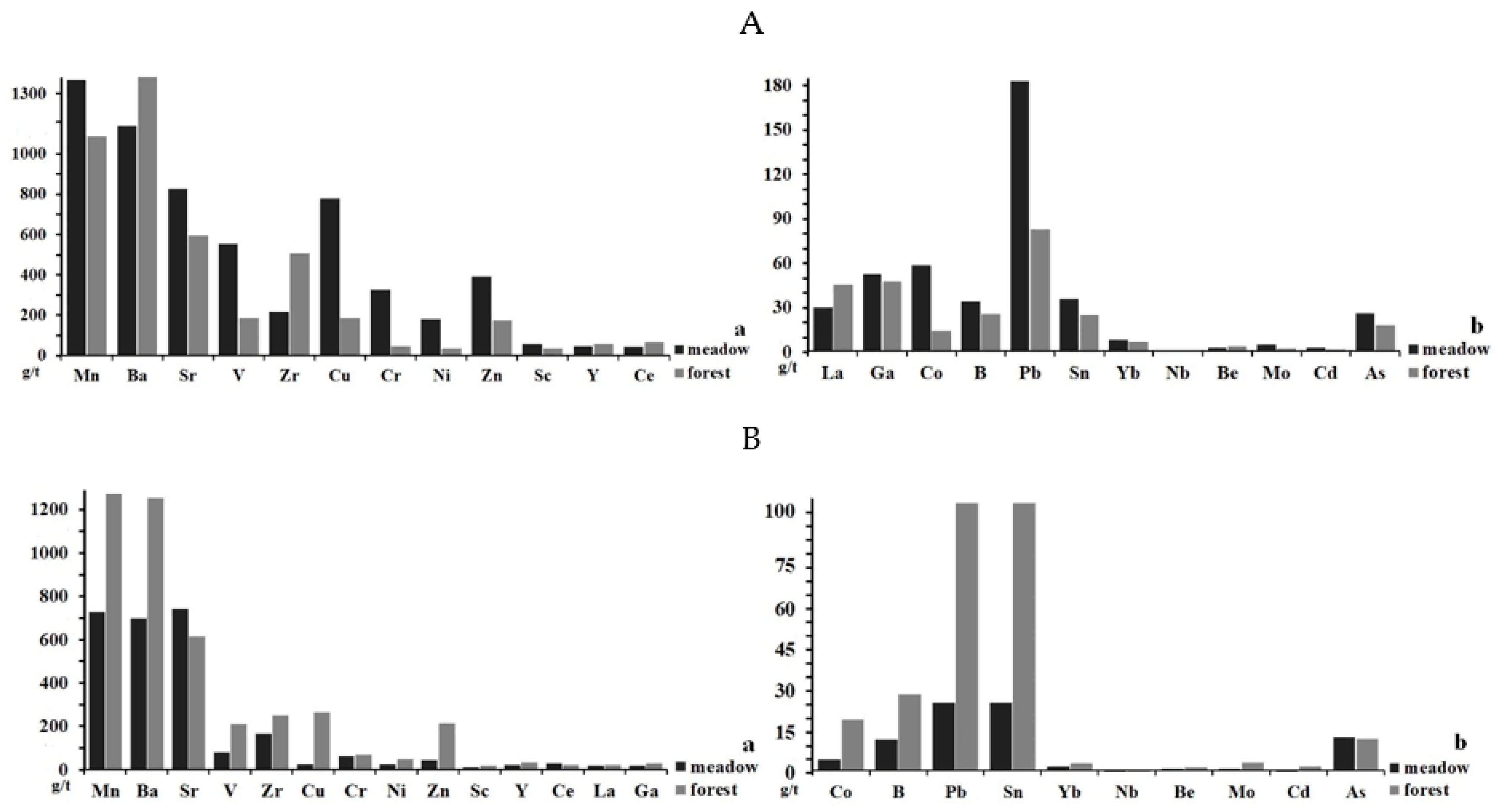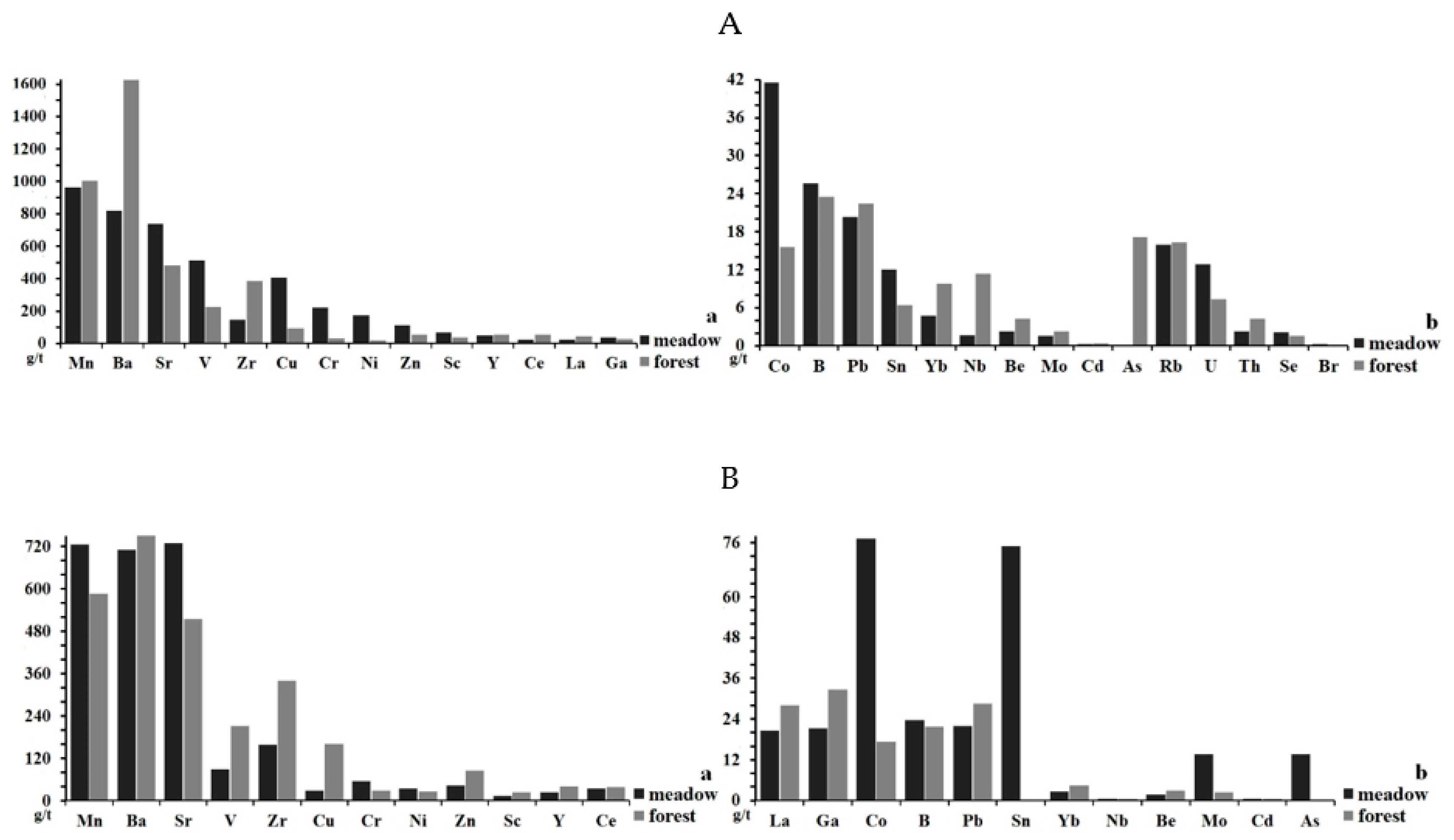Assessment of the Macro- and Microelement Composition of Fly Ash from 50-Year-Old Ash Dumps in the Middle Urals (Russia)
Abstract
:1. Introduction
2. Objects and Methods
3. Results and Discussion
4. Conclusions
Author Contributions
Funding
Institutional Review Board Statement
Informed Consent Statement
Data Availability Statement
Conflicts of Interest
References
- Khokhlov, A.; Melnikov, Y. Coal Generation: New Challenges and Opportunities; Energy Center of the Moscow School of Management: Skolkovo, Russia, 2019; p. 88. [Google Scholar]
- Danilov, A.S.; Pashkevich, M.A.; Petrova, T.A. Environmental integrated monitoring system at reclamation of large open-cast coal mine. Innovation-Based Development of the Mineral Resources Sector: Challenges and Prospects. In Proceedings of the 11th Conference of the Russian-German Raw Materials, Potsdam, Germany, 7–8 November 2018; pp. 189–194. [Google Scholar]
- Marinina, O.; Nevskaya, M.; Jonek-Kowalska, I.; Wolniak, R.; Marinin, M. Recycling of coal fly ash as an example of an efficient circular economy: A Stakeholder approach. Energies 2021, 14, 3597. [Google Scholar] [CrossRef]
- Shishelova, T.; Samuseva, M. Monitoring of ash dumps of TPS and ways to reduce their negative impact on the environment. Succ. Mod. Nat. Sci. 2005, 9, 65–66. [Google Scholar]
- Cherentsova, A.; Mayorova, L. The Impact of Landfill Disposal of Ash Waste from Power Plants on the Environment (Ash of Khabarovsk Thermal Power Plant No. 3 as an Example). Bull. PNU 2015, 3, 49–58. [Google Scholar]
- Krylov, D.A. The negative impact of elements of impurities from coal TES on the environment and health. Gorn. Inf. Anal. Bull. 2017, 12, 77–87. [Google Scholar] [CrossRef]
- Carlson, C.L.; Adriano, D.C. Environmental impacts of coal combustion residues. J. Environ. Qual. 1993, 22, 227–247. [Google Scholar] [CrossRef]
- Custovich, H.; Zurovec, O. Influence of soil water retention properties on hydrological cycle and water budgeting module simulation. Agric. Conspec. sci. 2011, 76, 65–69. [Google Scholar]
- Blissett, R.S.; Rowson, N.A. A review of the multi-component utilisation of coal flyash. Fuel 2012, 97, 1–23. [Google Scholar] [CrossRef]
- Telizhenko, O.M. Concept of integrated waste management as recoverable resources in product cycle. J. Environ. Sci. Eng. 2012, 1, 312–323. [Google Scholar]
- Di Maio, F.; Rem, P.M. A Robust Indicator for Promoting Economy through Recycling. J. Appl. Fundam. Res. 2015, 9, 23–27. [Google Scholar] [CrossRef] [Green Version]
- Yao, Z.T.; Xia, M.S.; Sarker, P.K.; Chen, T. A review of the alumina recovery from coal fly ash, with focus in China. Fuel 2014, 120, 74–85. [Google Scholar] [CrossRef] [Green Version]
- Yao, Z.T.; Ji, X.S.; Sarker, P.K.; Tang, J.H.; Ge, L.Q.; Xia, M.S.; Xi, Y.Q. A comprehensive review on the applications of coal fly ash. Earth-Sci. Rev. 2015, 141, 105–121. [Google Scholar] [CrossRef] [Green Version]
- Afanasyeva, O.V.; Mingaleeva, G.R.; Dobronravov, A.D.; Shamsutdinov, E.V. Complex use of ash and slag waste. Energy Probl. 2015, 7–8, 26–36. [Google Scholar]
- Rimkevich, V.; Pushkin, A.; Churushova, O. Complex processing of coal ash of TPS. Min. Inf. Analyt. Bull. (Sci. Techn. J.) 2015, 6, 250–259. [Google Scholar]
- Sato, K.; Fujiakawa, T. Effective use of coal ash as ground materials in Japan. Jpn. Geotech. Soc. Spec. Publ. 2017, 5, 65–70. [Google Scholar] [CrossRef] [Green Version]
- Valeev, D.; Kunilova, I.; Alpatov, A.; Mikhailova, A.; Goldberg, M.; Kondratiev, A. Complex utilization of ekibastuz brown coal fly ash: Iron & carbon separation and aluminum extraction. J. Clean. Prod. 2019, 218, 192–201. [Google Scholar] [CrossRef]
- Pichugin, E. Analytical review of the experience of involving ash slag waste of thermal power plants in economic circulation in the Russian Federation. Reg. Env. Iss. 2019, 4, 77–87. [Google Scholar]
- Cho, H.; Ji, S.; Shin, H.; Jo, H. A Case Study of Environmental Policies and Guidelines for the Use of Coal Ash as Mine Reclamation Filler: Relevance for Needed South Korean Policy Updates. Sustainability 2019, 11, 3629. [Google Scholar] [CrossRef] [Green Version]
- Yousuf, A.; Manzoor, S.O.; Youssouf, M.; Malik, Z.A.; Khawaja, K.S. Fly Ash: Production and Utilization in India. An Overview. J. Mater. Environ. Sci. 2020, 11, 911–921. [Google Scholar]
- Snikkars, P.N.; Zolotova, I.U.; Osokin, N.A. Increasing coal combustion product utilization in Russia as s cross-industry goal. Energy Policy 2020, 7, 34–44. [Google Scholar]
- Delitsyn, L.M.; Ryabov, Y.V.; Vlasov, A.S. Possible ash disposal technologies. Energy Sav. 2014, 6, 60–66. [Google Scholar]
- Valeev, D.; Mikhailova, A.; Atmadzhidi, A. Kinetics of iron extraction from coal fly ash by hydrochloric acid leaching. Metals 2019, 8, 533. [Google Scholar] [CrossRef] [Green Version]
- Valeev, D.; Kunilova, I.; Alpatov, A.; Varnavskaya, A.; Ju, D. Magnetic and carbon extraction from coal fly ash using magnetic separation and flotation methods. Mineral 2019, 9, 320. [Google Scholar] [CrossRef] [Green Version]
- Shoppert, A.; Valeev, D.; Loginova, I.; Chaikin, L. Complete Extraction of Amorphous Aluminosilicate from Coal Fly Ash by Alkali Leaching underm Atmospheric Pressure. Metals 2020, 10, 1684. [Google Scholar] [CrossRef]
- Holliday, R.; Townsend, W.M.; Hodgson, D. Plant growth on fly ash. Nature 1955, 176, 983–984. [Google Scholar] [CrossRef]
- Shishelova, T.I.; Samuseva, M.N.; Shenkman, B.M. Use of ash and slag waste as a sorbent for wastewater treatment. Mod. Sci. Int. Techn. 2008, 5, 20–22. [Google Scholar]
- Basu, M.; Pande, M.; Bhadoria, P.B.S.; Mahapatra, S.C. Potential fly-ash utilization in agriculture: A global review. Prog. Nat. Sci. 2009, 19, 1173–1186. [Google Scholar] [CrossRef]
- Shaheen, S.M.; Hooda, P.S.; Tsadilas, C.D. Opportunities and challenges in the use of coal fly ash for soil improvements—A review. J. Environ. Manag. 2014, 145, 249–267. [Google Scholar] [CrossRef] [Green Version]
- Kozhukhovsky, I.S.; Velichko, E.G.; Tselykovsky, Y.K.; Tskhovrebov, E.S. Organizational, economic and legal aspects of the creation and development of industrial and technical complexes for the processing of coal fly ash waste into construction and other products. MGSU Bull. 2019, 6, 756–773. [Google Scholar]
- Shakirov, A.V. Physical-Geographical Zoning of the Urals; UB RAC: Ekaterinburg, Russia, 2011; p. 618. [Google Scholar]
- Pasynkova, M.V. Ash of coal as a substrate for growing plants. Plants Ind. Environ. 1974, 29–44. [Google Scholar]
- Arynov, A.A. Coals of the Ekibastuz field. KarSU Bull. 2007, 1, 1–5. [Google Scholar]
- Makhonina, G.I. Ecological Aspects of Soil Formation in the Technogenic Systems of the Urals; Ural State University: Yekaterinburg, Russia, 2003; p. 356. [Google Scholar]
- World Reference Base for Soil Resources. International Soil Classification System for Naming Soils and Creating Legends for Soil Maps; Food and Agriculture Organization of the United Nations (FAO): Rome, Italy, 2014; p. 181. [Google Scholar]
- Arinushkina, E.V. A Guide in Chemical Analysis of Soils; Moscow State University Publishers: Moscow, Russia, 1970; p. 487. [Google Scholar]
- Vorobyova, L.A. Theory and Practice of Chemical Analysis of Soils; GEOS: Moscow, Russia, 2006; p. 400. [Google Scholar]
- Kachinsky, N.A. Mechanical and Microaggregate Composition of Soil, Methods of Its Study; Publishing House of the USSR Academy of Sciences: Moscow, Russia, 1958; p. 192. [Google Scholar]
- Cherevko, A.S.; Syso, A.I. Atomic Emission Spectrographic Determination of Trace Elements in Environmental Objects Using a Two-Jet Argon Arc Plasmatron. J. Anal. Chem. 2009, 64, 806–814. [Google Scholar] [CrossRef]
- Zvereva, V.V. Development of Methodological Approaches for Elemental Analysis of Tissues of the Human Heart and Blood Vessels by X-ray Fluorescence Analysis Using Synchrotron Radiation; Disertation Candidate of Chemical Sciences: Novosibirsk, Russia; Nikolaev Institute of Inorganic Chemistry: Novosibirsk, Russia, 2009; p. 131. [Google Scholar]
- Sidorina, A. Optimization of the Method for Determining the Elemental Composition of Biological Objects by the SRXRF Method. Ph.D. Thesis, Nikolaev Institute of Inorganic Chemistry Siberian Branch of Russian Academy of Sciences, Novosibirsk, Russia, December 2014; p. 134. [Google Scholar]
- Kasimov, N.S.; Vlasov, D.V. Clarkes of chemical elements as reference standards in ecogeochemistry. Vestn. MSU Seriya 5 Geogr. 2015, 2, 7–17. [Google Scholar]
- Taylor, S.R. Abundance of chemical elements in the continental crust: A new table. GCA 1964, 28. [Google Scholar] [CrossRef]
- Vinogradov, A.P. The average content of chemical elements in the main types of igneous rocks of the earth’s crust. Geochemistry 1962, 7, 555–571. [Google Scholar]
- Zonn, S.V.; Travleev, A.P. Aluminum. Role in Soil Formation and Influence on Plants; DGU: Dnepropetrovsk, Ukraine, 1992; p. 223. [Google Scholar]
- Kabata-Pendias, A. Trace Elements in Soils and Plants, 4th ed.; CRC Press: Boca Raton, FL, USA, 2011; p. 505. [Google Scholar]
- Alexandrova, T.N.; Lavrik, N.A. Assessment of carbon-containing technogenic formations in the south of the Russian Far East as a possible source of valuable components. Min. Inf. Analyt. Bull. (Sci. Techn. J.) 2009, 1, 340–349. [Google Scholar]
- Cherentsova, A.A.; Chernovalova, A.V.; Alexandrov, M.N.; Mayorova, L.P.; Nazarkina, A.V.; Matveenko, T.I.; Arefyeva, O.D.; Sokolova, A.M.; Derbentseva, A.M. Soils and Soil Cover of Technogenic-Industrial Systems of Territories of Thermal Power Plants; Publishing House of the Far Eastern Federal un-ty: Vladivostok, Russia, 2013; p. 88. [Google Scholar]
- Fedorova, N.V.; Mokhov, V.A.; Babushkin, A.Y. The analysis of foreign experience of using of the thermal power plants coal fly ash waste and the capabilities of multi-agent simulation of the recycling processes (Review). Ecol. Ind. Prod. 2015, 3, 2–7. [Google Scholar]
- Ilyin, V.B. Heavy Metals and Nonmetals in the Soil-Plant System; Publishing House of the Siberian Branch of the Russian Academy of Sciences: Novosibirsk, Russia, 2012; p. 218. [Google Scholar]
- Perelman, A.I.; Kasimov, N.S. Geochemistry of the Landscape; Publ, H., Ed.; Astrea-200: Moscow, Russia, 1999; p. 768. [Google Scholar]
- Shikhova, N.S. Ecological and geochemical features of the vegetation of the Southern Primorye and the species-specificity of arboriflora in the accumulation of heavy metals. Sib. For. J. 2017, 6, 76–88. [Google Scholar]
- Makhonina, G.I.; Akhmetyanova, L.G. Mineral composition of plants grown in ash dumps of thermal power plants in the Urals. Plants Ind. Environ. 1979, 6, 73–81. [Google Scholar]




| Percentage Share of Fraction (mm) | ||||||
|---|---|---|---|---|---|---|
| 1.00–0.25 | 0.25–0.05 | 0.05–0.01 | 0.01–0.005 | 0.005–0.001 | <0.001 | <0.01 |
| VTTPP ash dump, 0–20 cm | ||||||
| 9.4 | 51.4 | 16.2 | 6.7 | 8.3 | 8.0 | 23.0 |
| VTTPP ash dump, 30–50 cm | ||||||
| 17.5 | 47.9 | 21.8 | 5.3 | 3.5 | 4.0 | 12.8 |
| SUTPP ash dump, 0–20 cm | ||||||
| 10.8 | 35.9 | 30.2 | 6.0 | 6.6 | 10.5 | 23.1 |
| SUTPP ash dump, 30–50 cm | ||||||
| 9.5 | 32.6 | 39.9 | 7.9 | 5.7 | 4.4 | 18.0 |
| Indicators | Element Oxides | VTTPP Ash Dump | SUTPP Ash Dump | ||||
|---|---|---|---|---|---|---|---|
| Depth, cm | |||||||
| 0–10 | 10–20 | 30–50 | 0–10 | 10–20 | 30–50 | ||
| Content, % | SiO2 | 46.4 | 42.9 | 41.1 | 52.2 | 54.9 | 48.9 |
| Al2O3 | 30.3 | 30.3 | 31.8 | 29.8 | 31.6 | 37.6 | |
| Fe2O3 | 13.0 | 14.1 | 14.0 | 5.2 | 5.2 | 5.4 | |
| CaO | 3.6 | 5.1 | 5.5 | 4.9 | 2.9 | 2.7 | |
| MgO | 2.2 | 2.7 | 2.7 | 1.6 | 0.9 | 0.9 | |
| K2O | 1.4 | 1.6 | 1.4 | 1.4 | 1.0 | 1.0 | |
| Na2O | 0.4 | 0.2 | 0.3 | 4.3 | 2.3 | 2.1 | |
| TiO2 | 2.2 | 2.2 | 2.4 | 0.6 | 1.0 | 1.1 | |
| P2O5 | 0.8 | 0.4 | 0.3 | 0.3 | 0.3 | 0.3 | |
| Mole Ratio | SiO2/Al2O3 | 2.60 | 2.40 | 2.19 | 2.97 | 2.95 | 2.21 |
| SiO2/Fe2O3 | 9.49 | 8.12 | 7.80 | 26.68 | 27.79 | 24.07 | |
| SiO2/R2O3 * | 2.04 | 1.85 | 1.71 | 2.67 | 2.67 | 2.02 | |
| Element | Average Content, kg·t−1 | Clarke Values in the Earth’s Crust, kg·t−1 | |||
|---|---|---|---|---|---|
| Object 1 | Object 2 | [Kasimov and Vlasov, 2015] | [Vinogradov, 1962] | [Taylor,1964] | |
| Si | 192.3 | 228.6 | 288.3 * | 295.0 | 281.5 |
| Al | 165.6 | 195.8 | 76.10 | 80.50 | 82.30 |
| Fe | 103.2 | 39.79 | 40.60 | 46.50 | 56.30 |
| Ca | 39.31 | 19.30 | 25.66 | 29.60 | 41.50 |
| Mg | 16.29 | 5.43 | 14.95 | 18.70 | 23.30 |
| K | 11.57 | 8.26 | 23.24 | 25.0 | 20.90 |
| Na | 2.23 | 15.58 | 24.26 | 25.0 | 23.60 |
| Ti | 14.40 | 6.60 | 3.90 | 4.50 | 5.70 |
| P | 1.31 | 1.31 | 0.69 | 0.93 | 1.05 |
| Element | Average Content, g·t−1 | Clarke Values in the Earth’s Crust, g·t−1 | |||
|---|---|---|---|---|---|
| Object 1 | Object 2 | [Kasimov and Vlasov, 2015] | [Vinogradov, 1962] | [Taylor,1964] | |
| Mn | 984.2 | 656.5 | 770 | 1000 | 950 |
| Ba | 1224.6 | 1036.4 | 628 | 650 | 425 |
| Sr | 611.2 | 622.1 | 270 | 340 | 375 |
| V | 370.6 | 150.9 | 106 | 90 | 135 |
| Zr | 262.2 | 250.7 | - | 170 | 165 |
| Cu | 251.5 | 95.2 | 27 | 47 | 55 |
| Cr | 127.8 | 42.3 | 92 | 83 | 100 |
| Ni | 96.0 | 30.9 | 50 | 58 | 75 |
| Zn | 83.1 | 64.0 | 75 | 83 | 70 |
| Sc | 53.1 | 19.2 | - | 10 | 22 |
| Y | 52.9 | 32.6 | - | 29 | 33 |
| Ce | 40.4 | 36.4 | - | 70 | 60 |
| La | 34.8 | 24.4 | 32 | 29 | 30 |
| Ga | 33.1 | 27.0 | - | 19 | 15 |
| Co | 28.6 | 47.3 | 15 | 18 | 25 |
| B | 24.2 | 22.7 | 34 | 12 | 10 |
| Pb | 21.3 | 25.3 | 17 | 16 | 12.5 |
| As | 17.1 | 13.6 | 5.6 | 1.7 | 1.8 |
| Sn | 9.3 | 37.6 | 2.5 | 2.5 | 2 |
| Yb | 7.9 | 3.6 | - | 0.33 | 3 |
| Nb | 7.3 | 0.5 | - | 20 | 20 |
| Be | 3.3 | 2.3 | 2.3 | 3.8 | 2.8 |
| Mo | 1.9 | 2.1 | 1.1 | 1.1 | 2.5 |
| Cd | 0.3 | 0.4 | 0.09 | 0.13 | 0.2 |
| Element | Meadow Plants | Forest Plants | ||||||
|---|---|---|---|---|---|---|---|---|
| Content | Kac. | Content | Kac. | |||||
| Shoots | Roots | Shoots | Roots | Shoots | Roots | Shoots | Roots | |
| Trace elements, g·t−1 | ||||||||
| Mn | 346 | 651 | 0.25 | 0.48 | 2038 | 1273 | 1.88 | 1.17 |
| Ba | 1156 | 1529 | 1.01 | 1.34 | 3236 | 2390 | 1.69 | 1.25 |
| Sr | 1305 | 1630 | 1.58 | 1.97 | 2219 | 1503 | 3.74 | 2.53 |
| V | 80 | 198 | 0.14 | 0.36 | 35 | 177 | 0.19 | 0.96 |
| Zr | 33 | 70 | 0.15 | 0.32 | 23 | 43 | 0.05 | 0.08 |
| Cu | 137 | 279 | 0.18 | 0.36 | 171 | 251 | 0.92 | 1.35 |
| Cr | 83 | 96 | 0.25 | 0.29 | 60 | 33 | 1.24 | 0.68 |
| Ni | 28 | 64 | 0.16 | 0.36 | 89 | 57 | 2.34 | 1.50 |
| Zn | 557 | 1155 | 1.42 | 2.94 | 4132 | 3265 | 23.86 | 18.85 |
| Sc | 3.39 | 11.6 | 0.06 | 0.20 | 1.7 | 7.2 | 0.05 | 0.20 |
| Y | 6.1 | 16.5 | 0.13 | 0.35 | 5.5 | 35 | 0.09 | 0.60 |
| Ce | 15 | 25 | 0.34 | 0.57 | 31 | 176 | 0.49 | 2.75 |
| La | 4.4 | 11.2 | 0.15 | 0.37 | 5.8 | 35 | 0.13 | 0.77 |
| Ga | 5.6 | 9.8 | 0.11 | 0.19 | 2.5 | 7.3 | 0.05 | 0.15 |
| Co | 5.1 | 13.2 | 0.09 | 0.23 | 8.6 | 19.5 | 0.61 | 1.37 |
| B | 242 | 218 | 7.08 | 6.37 | 484 | 369 | 18.69 | 14.25 |
| Pb | 135 | 198 | 0.74 | 1.08 | 551 | 555 | 6.65 | 6.69 |
| Sn | 124 | 383 | 3.43 | 10.58 | 24 | 30 | 0.95 | 1.19 |
| Yb | 0.69 | 2.09 | 0.08 | 0.25 | 0.46 | 3.12 | 0.07 | 0.45 |
| Nb | 0.32 | 0.34 | 1.07 | 1.13 | 0.25 | 0.28 | 0.42 | 0.47 |
| Be | 0.72 | 1.38 | 0.26 | 0.49 | 0.56 | 1.39 | 0.15 | 0.37 |
| Mo | 21 | 23 | 3.89 | 4.26 | 13 | 17 | 5.00 | 6.54 |
| Cd | 10.9 | 19.4 | 3.41 | 6.06 | 28.8 | 36.3 | 16.00 | 20.17 |
| Macroelements, kg·t−1 | ||||||||
| Si | 160.7 | 153.2 | 0.91 | 0.86 | 23.36 | 51.88 | 0.10 | 0.22 |
| Al | 10.58 | 19.88 | 0.07 | 0.13 | 7.85 | 20.93 | 0.05 | 0.12 |
| Fe | 9.59 | 16.93 | 0.07 | 0.13 | 5.44 | 14.15 | 0.08 | 0.21 |
| Ca | 136.6 | 153.9 | 2.81 | 3.17 | 21.06 | 162.4 | 1.73 | 13.37 |
| Mg | 27.26 | 22.91 | 1.13 | 0.95 | 43.93 | 31.38 | 8.09 | 5.78 |
| K | 119.0 | 45.68 | 7.20 | 2.76 | 134.3 | 135.5 | 18.06 | 18.22 |
| Na | 3.87 | 2.68 | 1.74 | 1.20 | 3.65 | 3.95 | 1.64 | 1.77 |
| Ti | 0.82 | 1.70 | 0.07 | 0.14 | 0.37 | 0.65 | 0.02 | 0.04 |
| P | 34.97 | 24.37 | 8.02 | 5.58 | 45.88 | 32.83 | 15.02 | 10.75 |
Publisher’s Note: MDPI stays neutral with regard to jurisdictional claims in published maps and institutional affiliations. |
© 2021 by the authors. Licensee MDPI, Basel, Switzerland. This article is an open access article distributed under the terms and conditions of the Creative Commons Attribution (CC BY) license (https://creativecommons.org/licenses/by/4.0/).
Share and Cite
Dergacheva, M.; Trunova, V.; Nekrasova, O.; Siromlya, T.; Uchaev, A.; Bazhina, N.; Radchenko, T.; Betekhtina, A. Assessment of the Macro- and Microelement Composition of Fly Ash from 50-Year-Old Ash Dumps in the Middle Urals (Russia). Metals 2021, 11, 1589. https://doi.org/10.3390/met11101589
Dergacheva M, Trunova V, Nekrasova O, Siromlya T, Uchaev A, Bazhina N, Radchenko T, Betekhtina A. Assessment of the Macro- and Microelement Composition of Fly Ash from 50-Year-Old Ash Dumps in the Middle Urals (Russia). Metals. 2021; 11(10):1589. https://doi.org/10.3390/met11101589
Chicago/Turabian StyleDergacheva, Maria, Valentina Trunova, Olga Nekrasova, Tatyana Siromlya, Anton Uchaev, Natalya Bazhina, Tatyana Radchenko, and Anna Betekhtina. 2021. "Assessment of the Macro- and Microelement Composition of Fly Ash from 50-Year-Old Ash Dumps in the Middle Urals (Russia)" Metals 11, no. 10: 1589. https://doi.org/10.3390/met11101589
APA StyleDergacheva, M., Trunova, V., Nekrasova, O., Siromlya, T., Uchaev, A., Bazhina, N., Radchenko, T., & Betekhtina, A. (2021). Assessment of the Macro- and Microelement Composition of Fly Ash from 50-Year-Old Ash Dumps in the Middle Urals (Russia). Metals, 11(10), 1589. https://doi.org/10.3390/met11101589






